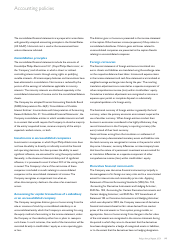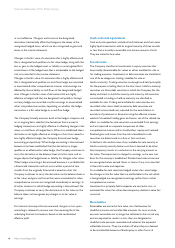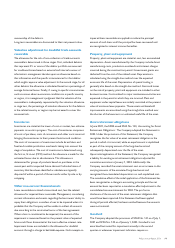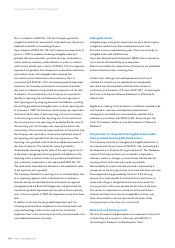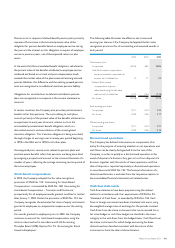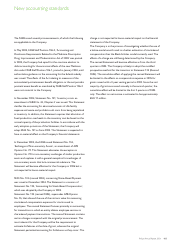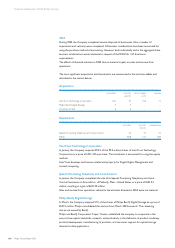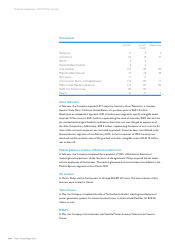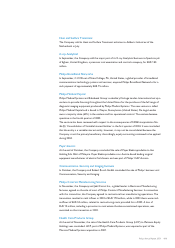Philips 2004 Annual Report Download - page 104
Download and view the complete annual report
Please find page 104 of the 2004 Philips annual report below. You can navigate through the pages in the report by either clicking on the pages listed below, or by using the keyword search tool below to find specific information within the annual report.
Pension costs in respect of defined-benefit pension plans primarily
represent the increase in the actuarial present value of the
obligation for pension benefits based on employee service during
the year and the interest on this obligation in respect of employee
service in previous years, net of the expected return on plan
assets.
In the event that the accumulated benefit obligation, calculated as
the present value of the benefits attributed to employee service
rendered and based on current and past compensation levels,
exceeds the market value of the plan assets and existing accrued
pension liabilities, this difference and the existing prepaid pension
asset are recognized as an additional minimum pension liability.
Obligations for contributions to defined-contribution pension
plans are recognized as an expense in the income statement as
incurred.
In certain countries, the Company also provides postretirement
benefits other than pensions. The cost relating to such plans
consists primarily of the present value of the benefits attributed on
an equal basis to each year of service, interest cost on the
accumulated postretirement benefit obligation, which is a
discounted amount, and amortization of the unrecognized
transition obligation. This transition obligation is being amortized
through charges to earnings over a twenty-year period beginning
in 1993 in the USA and in 1995 for all other plans.
Unrecognized prior service costs related to pension plans and
postretirement benefits other than pensions are being amortized
by assigning a proportional amount to the income statements of a
number of years, reflecting the average remaining service period of
the active employees.
Stock-based compensation
In 2003, the Company adopted the fair value recognition
provisions of SFAS No. 123, ‘Accounting for Stock-Based
Compensation’, as amended by SFAS No. 148, ‘Accounting for
stock-based Compensation – Transition and Disclosure’,
prospectively for all employee awards granted, modified or settled
after January 1, 2003. Under the provisions of SFAS No. 123, the
Company recognizes the estimated fair value of equity instruments
granted to employees as compensation expense over the vesting
period.
For awards granted to employees prior to 2003, the Company
continues to account for stock-based compensation using the
intrinsic value method in accordance with US Accounting
Principles Board (APB) Opinion No. 25, ‘Accounting for Stock
Issued to Employees’.
The following table illustrates the effect on net income and
earnings per share as if the Company had applied the fair value
recognition provisions for all outstanding and unvested awards in
each period:
2002 2003 2004
Net income (loss):
As reported (3,206) 695 2,836
Add: Stock-based compensation
expense included in reported net
income, net of related tax (5) 27 52
Deduct: Stock-based
compensation expense
determined using the fair value
method, net of related tax (147) (134) (115)
Pro forma (3,358) 588 2,773
Basic earnings per share:
As reported (2.51) 0.54 2.22
Pro forma (2.63) 0.46 2.17
Diluted earnings per share:
As reported (2.51) 0.54 2.21
Pro forma (2.63) 0.46 2.16
Discontinued operations
The Company has defined its businesses as components of an
entity for the purpose of assessing whether or not operations and
cash flows can be clearly distinguished from the rest of the
Company, in order to qualify as a discontinued operation in the
event of disposal of a business. Any gain or loss from disposal of a
business, together with the results of these operations until the
date of disposal, is reported separately as discontinued operations
in accordance with SFAS No. 144. The financial information of a
discontinued business is excluded from the respective captions in
the consolidated financial statements and related notes.
Cash flow statements
Cash flow statements have been prepared using the indirect
method in accordance with the requirements of SFAS No. 95,
‘Statement of Cash flows’, as amended by SFAS No. 104. Cash
flows in foreign currencies have been translated into euros using
the weighted average rates of exchange for the periods involved.
Cash flows from derivative instruments that are accounted for as
fair value hedges or cash flow hedges are classified in the same
category as the cash flows from the hedged items. Cash flows from
derivative instruments for which hedge accounting has been
discontinued are classified consistent with the nature of the
instrument as from the date of discontinuance.
103Philips Annual Report 2004






